6. ISLAM AND THE WEST DURING THOSE DARK DAYS

THE CAROLINGIAN REVIVAL
ca. 800
CONTENTS
 Islam challenges Western Europe Islam challenges Western Europe
 Charles Martel - Defender and eventual Charles Martel - Defender and eventual
king of France
 The retreat of the Umayyad dynast from The retreat of the Umayyad dynast from
the East
 The Spanish Reconquista gains The Spanish Reconquista gains
momentum
 The founding of the Carolingian dynasty The founding of the Carolingian dynasty
 Charlemagne Charlemagne
 The "Carolingian Renaissance" The "Carolingian Renaissance"
The textual material on page below is drawn directly from my work
A Moral History of Western Society © 2024, Volume One, pages 204-216.
|
A Timeline of Major Events during this period
1. Islam
challenges Western Europe
687 Austrasian Mayor of the Palace Pepin of Herstal
conquers Neustria
and
Burgundy
… making himself duke and
prince of the Franks …
then soon also
Alemannia, Frisia, and Franconia
711 Muslim Arabs under Tariq cross from North Africa to
conquer most of Visigothic
Spain (711-718) … establishing
a capital at Cordoba
714 With Pepin's death, several sons compete for his
position
(714-718)
with
Charles Martel (the Hammer) finally successful
Charles continues the conquering in Germany … and installing
new
Austrasian kings
721 The Muslims try to invade southern France, but are stopped brutally (huge loses on
both
sides)
by Odo, the Duke of Aquitaine
732 But the Muslims make a second attempt, crushing Odo's
army and
then heading north
into the Loire Valley
At the Battle of Tours, the army of Austrasian Mayor of the Palace Charles
Martel
defeats the Muslims
737 The Muslims try again (unsuccessfully) to defeat
Martel (735-739) …
but ultimately retreat back into Spain (al-Andalus)
Charles Martel finally leaves the
Austrasian kingship empty
741 When Charles dies his position is taken by his son Pepin
the Short
who aligns
his dynasty politically with the Church in Rome
750 The Umayyad dynasty loses out to the Abbasid dynasty
in the
heart of the Muslim Empire
… with the new Abbasid
capital relocated to Persian Baghdad
But an isolated Umayyad dynasty will stay in power in
Spain for
the next 700 years
However, Christians under Alfonso I also (mid-700s) begin the Spanish
Reconquista
752 Pepin forces the Muslims to retreat south of the
Pyrenees (752-759)
760 Pepin brings
Aquitaine under his rule (760-768), and forces the
Lombards to return
papal lands to the pope … gaining papal
support
2. Charlemagne develops greatly the Carolingian Empire
768 With Pepin's death, his son Charlemagne takes power
774 Charlemagne
forces the Lombards to com under his rule
787 Charlemagne forces most of
the rest of Italy under his rule (787-788)
And he moves ever deeper eastward into Germanic and
Slavic lands
800 Pope crowns Charlemagne as emperor" (Christmas 800)
Charlemagne installs a feudal system across his
empire
... replacing Germanic egalitarianism with
lord-vassal relations
A cultural revival of sorts stirs within Western Europe
ISLAM CHALLENGES
WESTERN EUROPE |
|
The Muslim conquest of Spain (Muslim "al-Andalus")
By the early 700s, there seemed to be no stopping the spread of
Islam. It headed West across the Mediterranean coastline of North
Africa, ... under the conqueror Tariq reaching the Atlantic and then
turning north across the narrow Gibraltar straits1
in 711 to head into Christian Spain. Tragically, Visigothic Spain
at the time was deeply caught up in a civil war among the
Visigoths. Thus the Muslims ended up rolling easily over the
entire Visigothic kingdom after defeating the Visigothic army at the
Guadalete River in 712.2
Then soon joined by a larger Arab army led by Musa ibn Nusayr, Muslim
governor of Ifriqiya, the two Muslim groups spread Umayyad rule even
deeper into Spain over the next seven years ... even capturing
Visigothic Septimania in coastal southern France.
However a small group of Christian Visigoths were able to hold off the
Muslim onslaught by retreating into the Cantabrian mountainous in the
north of the Iberian Peninsula... where, restructured as the small
Kingdom of Asturias, Christians would take refuge for the next few
centuries.
And thus was the foundation of a huge Islamic Spain, then known as al-Andalus, with its capital at Cordoba.
Action north of the Pyrenees Mountains into Southern France
Duke Odo and the Battle of Toulouse (721).
In 721 the Umayyad governor al Samh decided to complete the conquest of
Southern France by heading west from Umayyad controlled Narbonne in
coastal Septimania (where al Samh had established his capital) with an
immense Muslim army. His goal was Toulouse, the capital of
Christian Aquitaine. He had almost brought the city of Toulouse
to defeat when he and his army were suddenly surrounded by an equally
immense Christian army led by Odo, Duke of Aquitaine. Surprised
Muslims fled or were cut down in such huge numbers that the battle
amounted to a very bloody, very humiliating defeat for the Umayyad army
(though at a cost almost as high among Odo's Christians).3 The Umayyad governor al Samh escaped, but died soon thereafter from his wounds.
1Gibraltar is named after him: Jabal-al-Tariq or “mountain of
Tariq.”
2The
militias
3Muslim
tradition stated that the Muslims lost over 350,000 soldiers ... and
the Christians near that number at 300,000. The number seems to
be probably a huge exaggeration ... but in any case, very indicative of
the huge loss that both sides experienced at this battle. Also,
the Muslim historians themselves placed greater strategic significance
on their strategic loss at the hands of Odo at Toulouse than they did
on the disaster they experienced eleven years later at Tours at the
hands of Charles Martel.
4Muslim
tradition stated that the Muslims lost over 350,000 soldiers ... and
the Christians near that number at 300,000. The number seems to
be probably a huge exaggeration ... but in any case, very indicative of
the huge loss that both sides experienced at this battle. Also,
the Muslim historians themselves placed greater strategic significance
on their strategic loss at the hands of Odo at Toulouse than they did
on the disaster they experienced eleven years later at Tours at the
hands of Charles Martel.
CHARLES MARTEL – DEFENDER AND EVENTUAL KING OF FRANCE |
|
Frankish governor Charles Martel enters the picture
Despite Odo's huge victory over the Muslims at Toulouse, the Umayyads
were able to regroup and continue their raiding of Odo's Aquitaine from
their well supplied coastal base at Narbonne At one point Odo
attempted an alliance with the frustrated Berbers (as much in defense
against the expansive Franks to the North as the expansive Umayyads to
the East). But this did not seem to suffice to fend off the
Umayyad Arabs and the situation grew so desperate that Odo finally
appealed to his Frankish rival to the north, Charles Martel, for
help. Charles agreed, on the condition that Odo submit to
Charles' authority.
The Austrasian Mayor of the Palace, Pepin of Herestal, had been
directed by one of his wives, Plectrude, to appoint their grandson
Theudoald to replace him at his death ... ultimately 714. But at
that point, Theudoald was a mere 8-year-old child. Then Charles,
one of Pepin's sons by another wife, escaped the imprisonment imposed
on him by Plectrude, and moved decisively to put down rebellions among
the Neustrian nobles (the Frankish civil war of 715-718) ... restoring
the unity of Francia – and making very clear who was exactly in charge
in Francia. Graciously, Plectrude was sent to a convent and
Theudoald lived out his life under his uncle Charles's protection.
Then – as the Austrasian Mayor of the Palace – Charles proclaimed
Chlothar IV as King of Austrasia ... and replaced Rigobert as
Archbishop of Reims with a political ally of his, Milo, Bishop of
Trier. But when Chlothar died Charles switched his support to
Chlothar's rival, Chilperic ... on the condition of being named Mayor
of the Palace for all of Francia. Then in the name of King
Chilperic he went conquering to the East in Germany, bringing Alemannia
and Bavaria under Frankish rule. Then when Chilperic died,
Charles brought the young Theuderic IV to the throne ... though keeping
real power in his own hands. Meanwhile he continued the military
task of bringing kingdoms both at home and abroad under his rule.
By 730 he had a wide realm solidly under his control.
At the same time, Charles had been professionalizing his Frankish
troop. In those days, volunteer troops, the basis of most tribal
armies, would only serve the short period between the time when crops
were established and growing and then when they had to be
harvested. Charles instead paid his troops ... by confiscating
the wealth of the churches and monasteries in his realm – bringing on
him the danger of excommunication by Catholic authorities.
But having a professional – and well-tested – army available in 732
would be a surprise to the Muslims ... and the possible salvation of
Western Christianity (the Church would recognize this soon
enough!). At the same time the Muslims were not particularly
observant of how well the Franks under formerly Pepin and now Charles
were growing as a Christian military power. That would be a huge
mistake.
The Battle of Tours/Poitiers (732)
In 732 the Umayyads under Abd al Rahman undertook a massive invasion of
Odo's Aquitaine – this time delivering Odo a crushing blow ... and then
heading north towards the Loire Valley, burning and plundering as they
went, with the wealthy abbey of Saint Martin of Tours as their next
objective. Suddenly, just north of Poitiers, they ran into
Charles Martel's well positioned and highly experienced army blocking
the route to Tours. For seven days the Muslims attempted small
skirmishes to draw out the Franks ... or at least dislodge them from
their well defended position. Finally on the seventh day the
Muslim cavalry charged Charles's infantry ... only to find Charles'
troops surprisingly unyielding. Then a rumor spread among the
Muslims that some Franks had raided their base camp to steal the
plunder and free the slaves they had taken at Bordeaux ... and groups
of Muslim troops broke off the battle to retreat to the base
camp. But the retreat turned into an undisciplined rout ... with
Abd al Rahman himself killed in the retreat. At the dawn of the
next day the Franks were surprised to discover the Muslim camp
abandoned.
Continuing Muslim attacks
Umayyads under a new governor would attempt another large invasion of
Francia in 735 ... and reach northeastward into Burgundy ... even as
far north as Lyons. Charles Martel would counter with attacks
into Septimania (736 and 739), taking various cities as he went ... but
fail to dislodge the Muslims at Narbonne. The Muslims would, in fact,
remain in Narbonne for another 20 years.
Berber rebellion
In the meantime, huge communities of Muslim Berbers and Arabs had been
brought to settle al-Andalus, with the Berbers being assigned the areas
of the north most susceptible to Christian counterattacks ... a matter
of some bitterness infecting the relationship between the Muslim Arabs
and Berbers. In fact Berber rebellions were frequent, especially
one that took place across Spain and North Africa in 740 ... which was
put down only in 742 by an Arab Syrian army and then occupied by Syrian
governors. The latter strengthened the Muslim hold over Spain ...
but also formed the foundation for a number of rather autonomous feudal
estates.
Alfonso I starts the Spanish Reconquista
Meanwhile, the Berber rebellion and the Berber evacuation of the
frontline against Asturias – as well as the humiliating thrashings the
Umayyads received at Toulouse and Tours – allowed Christian King
Alfonso I (ruled Asturias 739-757) to take over the abandoned Berber
forts in northern Spain and add the provinces of Galicia (740) and Leon
(754) to his northern kingdom.
The Reconquista or "reconquering" of Spain by the Christians had thus begun. It would take another 650 years to finish the job.
|
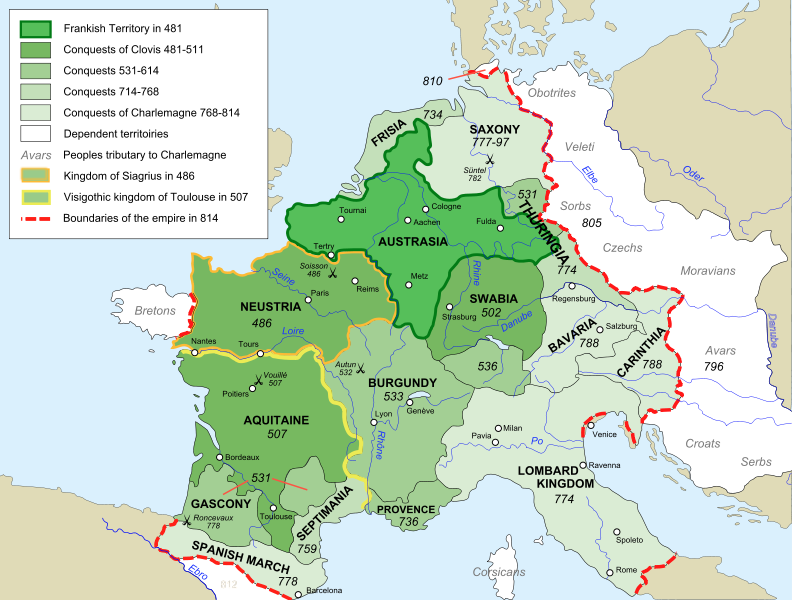
Map showing the growth of the Frankish
Kingdom
(From: William R.
Shepherd, "The growth of Frankish power, 481–814," Historical Atlas,
1926 edition, p. 53)
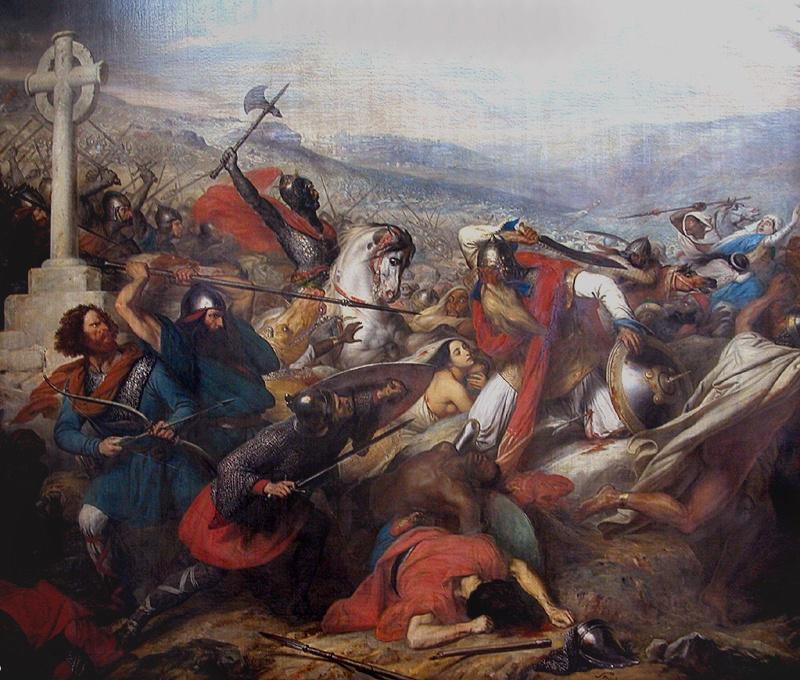
Charles de Steuben, Bataille
de Poitiers, en octobre 732
Musée du château de Versailles,
France
THE RETREAT OF THE UMAYYAD DYNASTY FROM THE EAST |
|
The End of the Umayyad Caliphate in Syria (750)
Meanwhile, huge problems developed for the Umayyads when a member of
the Hashemite group, Al-Saffah put forward his own personal claim to
dominion over the Islamic Ummah ... on the basis of his direct descent
from an uncle of Muhammad named Abbas (thus giving a name to him and
his future dynasty as the "Abbasids"). He also cultivated an
ever-widening power base among the Persians, who resented the
pretensions of the Arab aristocracy, considering desert Arabs to be
naturally inferior to the those born to what was clearly the superior
Persian civilization. Thus a bit of nationalism (Persian versus
Arab) was rising within the world of Islam ... a nationalism that
al-Saffah was glad to exploit in order to bring himself to power.5
In 747 the Abbasid military seized control from the Umayyad governor in
Persia ... and under the command of the Persian general Abu Muslim
moved their troops westward, driving back the Umayyad forces facing
them. In 749 the Abbasids were so bold as to declare their leader
al-Saffah as the new caliph (749-754) and the following year met and
defeated a huge Umayyad army in northern Iraq.
The Umayyad caliph was able to escape to Egypt, but was caught and
beheaded ... thus bringing the Umayyad caliphate in Damascus fully to
an end.
Now began the eradication of Umayyad power everywhere ... in a highly
brutal fashion – including the slaughter of 80 members of the Umayyad
clan leadership at a banquet supposedly called to work out an Arab-like
compromise.
At this point the central seat of Islamic power was moved East from
Damascus in Syria to Baghdad in Persia ... also bringing Islam under
greater Persian cultural influence (art, music, literature). And
although the Abbasids used all the Shi'ite support they could gather
... they would remain staunchly Sunni in character.
The Umayyads Continue to Rule in Isolation in Spain for the Next Seven Centuries
Abd al-Rahman I.
Only one Umayyad, Abd al-Rahman, escaped the slaughter of his kinsmen
... and made his way to al-Andalus (Spain). Here he took control
of the Islamic government at Cordoba and declared himself Emir or
Governor, of a fully sovereign Emirate operating independently of the
Abbasid Caliphate seated at Baghdad.
But his rule was not secure ... either along the north with the border
with the Christian principalities nor to the south across the straits
of Gibraltar in Afriqiya (Africa).
The emirs after him had an even harder time holding onto their power
.... for by 900 the power of the Umayyad Emir did not extend much
beyond the capital of Cordoba itself.
Abd al-Rahman III.
Then in 912, Abd al-Rahman III was able to bring all of al-Andalus and
parts of Northwestern Africa back under Umayyad power ... restoring the
region to a peace that it had not enjoyed for generations ... and
taking for himself the title of Caliph.
This brought the Umayyad Caliphate to a level equaling even the Shi'ite
Fatamid Caliphate based in Tunisia, the Umayyad's major competitor for
control of North Africa.
For the next century the region grew greatly prosperous, expanding its
trade ... and strengthening the character of its intellectual and
artistic culture ... to a level unsurpassed in the rest of Islam ...
and to the great admiration of even Christian Europe.
5This
Persian spirit of hostility towards their Arab overlords was a major
reason that the Persians identified themselves with the minority
Shi'ites, in opposition to the majority (and largely Arab)
Sunnis. Persia or modern Iran even today takes very seriously
this same quite hostile – and quite nationalist – Shi'ite position.
THE SPANISH RECONQUISTA GAINS MOMENTUM |
The gradual breakdown of Umayyad power in Spain
However a civil war among the Umayyads greatly weakened their power ...
and little by little, during the 970s al-Mansur (known to the West as
Almanzor) – the vizier or advisor to a very young Umayyad Caliph Hisham
– took ever greater control over the affairs of state ... until by 980
he was in total control of the caliphate. With his incredible
energy he took on the Christian states in Northern Spain ... winning a
number of battles ... but thereby driving the Christians into a greater
unity of effort against him.
Then when al Mansur died in 1002, his first son ruled a short six years
before dying … and a very ambitious half-brother took over, even trying
to take the title of caliph away from Hisham. This precipitated a huge
civil war among the Muslims... which in turn by 1030 had broken the
Muslim state into a number of now fiercely competing Muslim taifa or
principalities – thus shattering Umayyad power and bringing the Umayyad
caliphate to an end (1031).
The Spanish Reconquista gains momentum
This in turn now gave the Christian kingdoms (Asturias, Leon, Castile,
Navarre and Aragon) the opportunity to begin their advance (the
Reconquista or "reconquest") against the various Islamic states ... a
process which would continue over the next 450 years until the last
Muslim taifa or state of Granada was overthrown in 1492, closing out
permanently the long Muslim presence in Spain (also the year of the
Spanish-sponsored discovery of America by Columbus!).
El Cid.6
A Christian Castilian knight of the second half of the 1000s would play
a huge symbolic role in this process of the Christian reconquering of
Spain … although for his personal traits as a warrior – rather than on
the basis of any full loyalty to the Christian cause! In fact, Rodrigo
Diaz de Vivar served both local Christian and Muslim lords … depending
on the various shifts in his personal political status. Nonetheless,
"El Cid" would not only come to be a major icon (even down to today) as
an agent of the Reconquista … but would also exemplify the extreme
complexity of the Muslim-Christian mix that dominated so much of Spain
for seven centuries.
In many important ways, a Muslim-Christian Spain
would leave an intellectual- cultural legacy that would run deep within
a reviving post-Roman Christian world … in close conjunction with the
Muslim impact on Western culture that would also come to Europe via the
Christian crusades to the Muslim Middle East, crusades that were about
to break forth also at the closing of the 1000s.
6From
al-Sayyid: An Arabic political title meaning "the Lord" – received by
Rodrigo in his military service to the Muslim King of the Taifa of
Zaragoza.
THE FOUNDING OF THE CAROLINGIAN DYNASTY |
|
Charles Martel's legacy
In 737, Theuderic, King of the Franks, died ... and Charles Martel
neither took the royal title for himself nor selected another member of
the declining Merovingian family to take the position. The
position of King remained vacant for the rest of Charles's days.
But of course Charles was totally in charge of the politics of this
vast kingdom ... principally by forcing the rather self governing dukes
and counts to acknowledge his sovereign rule over them, or by personal
appointments of new dukes and counts ... not infrequently achieved by
brutal military action. However he continued to respect the
relative autonomy of Odo in Aquitaine ... and his son Hunald who took
title as Duke of Aquitaine when Odo died in 735.
Charles was also a very active agent of the Catholic Church ...
providing heavy support to (Saint) Boniface as archbishop of Charles's
extensive holdings east of the Rhine River ... with Boniface offering
in return strong church support for Charles's rule.
Pepin the Short (or "Lesser")
In 740, a year before his death, Charles designated his two sons as
governors of his extensive kingdom: the older Carloman receiving
Austrasia, Alemannia and Thuringia and the younger Pepin receiving
Neustria, Burgundy, and Provence. Though both sons were
devout Christians, educated by the monks of St. Denis (Paris), the
quite pious Carloman in 747 took up monastic life at Monte Casino
(Italy), leaving all of Francia to Pepin.
Then an "understanding" developed between Pepin and Pope Zachary in
751, the latter who in exchange for Pepin's support against the
hard-pressing Lombards in Italy declared the useless Merovingian
kingship to have ended. This then allowed an assembly of Frankish
nobles to elect Pepin as King of the Franks ... and then have his
friend Boniface officiate at Pepin's coronation that same year.
Thus was established the foundations of the new Carolingian dynasty as
Frankish kings.
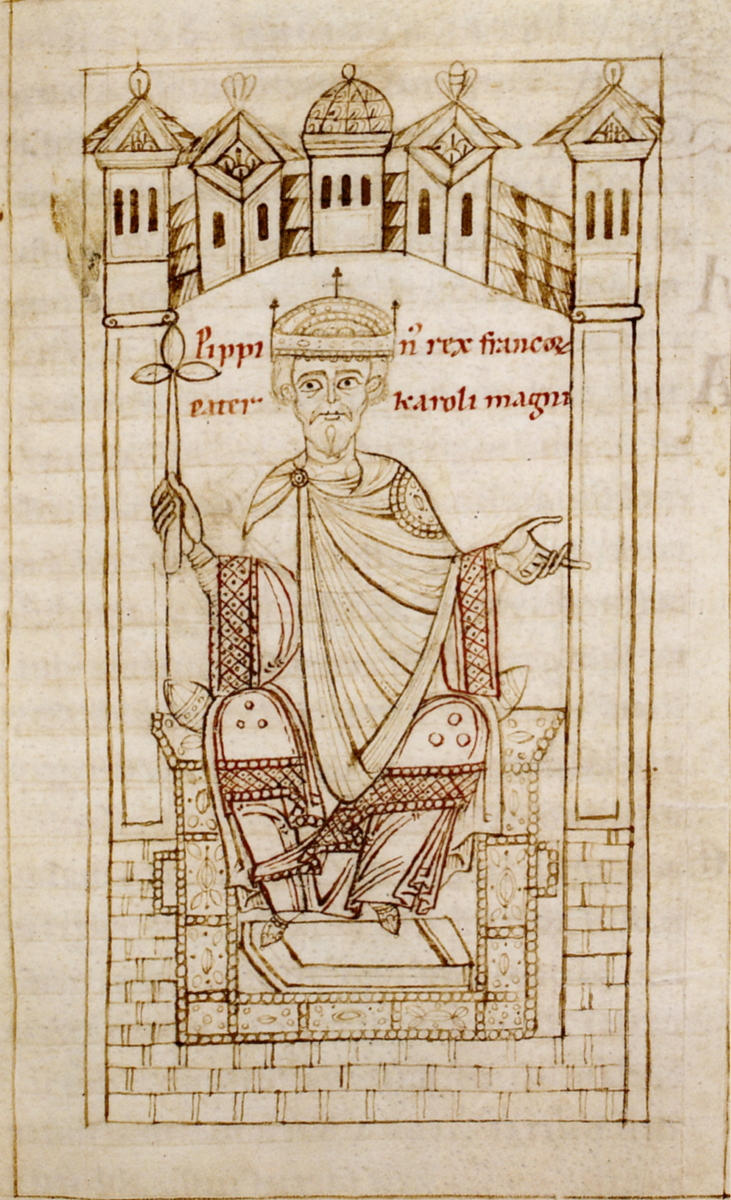
The following year, the new pope Stephen II traveled to St. Denis to
officially anoint Pepin as Roman Patrician (and thus protector of the
Roman papacy) ... and his sons, the 12-year-old Charles (Charlemagne)
and 3-year-old Carloman as eventual inheritors of their father's
positions and titles. In return, Pepin forced the Lombard king to
return Italian lands taken from the Church ... an action which came to
be known as the "Donation of Pepin" ... certifying the Church as a
major participant in what was beginning to take shape as the European
feudal system.
Pepin was naturally busy forcing local rulers to either acknowledge his
suzerainty ... or be replaced by Pepin's own appointments. He
also took the offensive against the Muslims of Septimania at Narbonne
... requiring seven years (752-759) to drive the Muslims – permanently
– from this last bit of territory they held north of the
Pyrenees. He then turned his attention to the duchy of Aquitaine
in order to force that region as well to submit to his sovereign
rule. It would take eight long years (760-768) of bloody warfare
and brutal devastation to complete the task ... achieved just before he
died in 768.
|
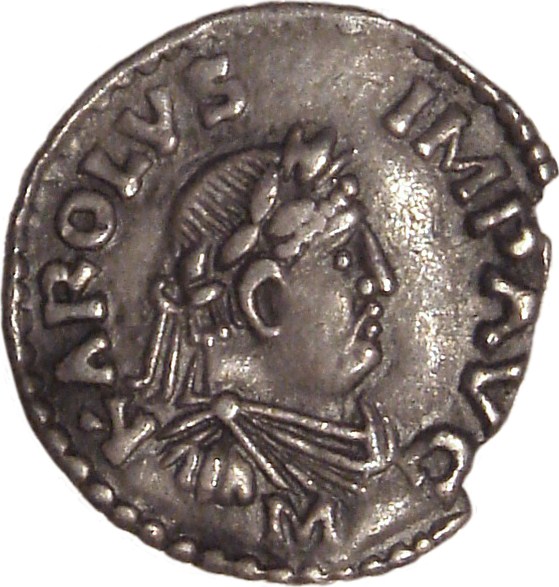 In
coming to power in 768 Charles (eventually "Charlemagne" or "Charles
the Great") found himself facing a serious revolt in Aquitaine ...
which he was able to put down fairly quickly ... even without the
assistance of his brother Carloman, with whom relations became
strained. But Carloman would not factor long in the scheme of
Carolingian politics, for he died in 771 – only 20 years old. In
coming to power in 768 Charles (eventually "Charlemagne" or "Charles
the Great") found himself facing a serious revolt in Aquitaine ...
which he was able to put down fairly quickly ... even without the
assistance of his brother Carloman, with whom relations became
strained. But Carloman would not factor long in the scheme of
Carolingian politics, for he died in 771 – only 20 years old.
Against the Lombards.
Charles now turned his attention to the Lombards ... and their
contention with Pope Adrian over the title of the lands of northern
Italy. Charles sided with the pope, and attacked the Lombards at
Pavia in 773 to force them to yield ... which, surrounded and now quite
desperate, they surrendered the next summer (774). This then
allowed Charles to take the crown as King of the Lombards ... not that
this would not be contested by Italian dukes. Indeed Charles in
776 had to put down a rebellion led by two of the Italian dukes.
Eventually Charles was able to extend Frankish rule all the way south
to Salerno (787), also pressuring the Duke of Benevento to recognize
Charles's suzerainty in 788 ... influenced in part by a countering
pressure coming from the Byzantine Empire based to the south at the
base of the Italian peninsula.
In 781 he had designated his son Pepin (originally at birth "Carloman")
– still yet a child – as King of Italy (and confirmed by Pope
Adrian). Pepin would eventually take up heavy responsibilities of
governance and military leadership quite well ... leading some of his
father's regional armies in the constant warfare that took place during
his father's rule.
Against the Umayyad Moors of al-Andalus (Spain).
On another front, an opportunity to extend Christianity back into Spain
seemed to present itself when local Muslim rulers promised to
acknowledge him as their king ... if he would break the power of the
Umayyad Emir Abd al-Rahman. But despite gathering a huge army of
Franks, Burgundians and Lombards at Saragossa in 778, they were not
able to defeat the city ... and Charles finally gave up ... only to
have hostile Basques7
– bitter because of Charlemagne's destruction of the walls of their
capital city, Pamplona – attack the rear of his army at Roncesvalles as
he retreated north across the Pyrenees.8
Charles reacted by taking direct control of Aquitaine and placing
another son Louis (the Pious) over the province as its new king.
However, despite the humiliation at Saragossa, Charles continued to
receive homage as nominal ruler in the Catalan region of Northeastern
Spain ... because of the bitter feelings the local Muslim leaders felt
towards the Muslim authorities at Cordova. Thus Charles's troops
received Barcelona without a fight in 797 ... lost it in 799 to the
Umayyads and then regained it again in 801. From there the Franks
extended their boundaries deeper into Spain along the Mediterranean
coast, all the way to the Ebro River ... thereby founding the "Spanish
March."
Against the Saxons.
Meanwhile Charles had been pressing his borders deeper across Germania,
defeating one Saxon tribe after another (pretty much over the entire
course of his years of rule) ... bringing the Saxons to convert to
Catholic Christianity as a part of his effort to solidify the
foundations of his growing domain. But revolts among the Saxons were
not uncommon.
The Avars. Also,
his son Pippin fought the nomadic Asian Avars when they invaded Bavaria
and the German lands along the Danube River ... finally defeating them
in 796 and bringing them into the Catholic faith.
The Slavs. To the
West of the Saxons were the Slavs, against whom Charlemagne led his
army ... only to have the Slavs offer little resistance – but instead
submit rather willingly to his rule, accepting his Catholic faith in
the process. Indeed, the Slavs would become important allies in
some of Charlemagne's further efforts to put down Saxon
rebellions. They also served as allies in Pepin's battles with
the Avars.
Charlemagne crowned Emperor by Pope Leo III (800).
In December of 800 Charlemagne was in Rome visiting his friend Pope Leo
III – who had taken refuge at Charlemagne's court the previous year
when the Pope found himself in danger from local Romans. On
Christmas Day Pope Leo crowned Charlemagne as "Augustus" (Roman
Emperor).
The exact meaning of this action was not clear ... even at the
time. Some claimed that this made him Emperor of all the Roman
Empire – taking up the inheritance of an unbroken line of Roman
emperors that had continued via the Eastern or Byzantine Empire.
At the time, the Byzantine Empire was headed by Irene, who held her
position as Empress by having had her son Leo VI blinded (who soon died
of his wounds) ... making her position appear highly illegitimate to
many. Thus, to those same people, this coronation made Charles –
not Irene – Rome's true Emperor. But Charles was not interested
in involvement in Mediterranean politics ... having enough problems to
deal with at the borders of – or even within – the territories where he
had extended Frankish rule directly. Nonetheless, this matter of
Emperorship would continue to vex East-West Roman Christian relations
for many centuries to come ... as the imperial title granted to
Charlemagne by the Pope would be passed on (with a brief break) by
future popes to future Western leaders.
The development of the feudal system
European feudalism, though basic elements had been put in place by
earlier Frankish kings, took a highly developed form under
Charlemagne. In conquering these numerous German and Slavic
tribes (Franks, Visigoths, Burgundians, Lombards, Alemanni, Avars,
Croatians, etc.),9 he had a far-flung and culturally highly diverse Empire to govern.
Charlemagne saw himself not just as a military dominator over numerous
tribes, sort of a tribal superchief. Instead, he understood
himself to be something of a landlord, in full personal ownership of
the lands and people he had conquered, to do with as he himself
personally chose. Thus by receiving from the hands of the Pope
the title of Emperor, Charlemagne had received the recognition and
support – even blessing – of the powerful Church to this amazing
political claim.
A relationship of Lord and Vassal.
But Charlemagne had no extensive bureaucracy at hand to help him govern
this massive estate, to organize the repair of roads and towns, to
police the highways, to collect the taxes, etc. such as the earlier
Roman emperors possessed. So Charlemagne had to improvise.
Instead he placed sons where he could over portions of his territory –
now legally an Empire – and leased portions of the rest of his empire
to personal supporters termed "vassals", giving sons and vassals the
right to govern in his place at the more local levels of society.
This privilege – and responsibility – placed supporters of this system
under the obligation not only to supervise the peace of Charlemagne's
realm in their particular assigned districts (duchies, counties,
principalities, etc.), but to provide taxes and military service when
called on by the emperor to do so. Once assigned a place in
Charlemagne's organization, these vassals could then turn around and,
as lords (dukes, barons, counts) themselves of one of Charlemagne's
regional realms, appoint vassals of their own to help govern smaller
portions of their duchies or principalities.
Thus feudalism. And
thus the system of sub-infeudation (sub-leasing) or "feudalism" was
born ... a system by which the older, somewhat "democratic" Germanic
idea of tribal territories presided over by elective tribal councils
and tribal kings was replaced by a new "proprietary" system in which
all-powerful "landowners" placed at various level of this feudal system
were placed in total control of what was now considered almost
"personal" (or family) territory.
This new "feudal" setup was given legitimacy by special rites of
anointing extended to these landed rulers by officers of the Church
(bishops, archbishops, and even, when the position was important
enough, the Pope at Rome). Who then dared to contest what the
Church (and thus supposedly God himself) had ordained?
The rightless masses (peasants).
The masses of common people who worked the farmlands of these feudal
proprietors were now relegated to the level of possessions, something
like cattle. They were peasants with only the rights accorded
them by the lords (and ladies) who ruled absolutely over them.
The peasants and their lands could be bought, sold, exchanged, or
gifted freely – without any consultation with the peasants themselves –
to other lords belonging to the privileged circle of the feudal
aristocracy that Charlemagne had created ... and the Church authorized
and certified.
This system would remain intact in Europe for the next thousand years –
until the rise in the 1800s of nationalism and the accompanying
doctrine of popular democracy.10
7The
Basques – located primarily in Northern Spain – are a people whose
language is unlike any of the Indo-European languages … and for that
matter any language spoken elsewhere in the world. The
supposition is that they are the descendants of a people who once
inhabited a larger portion of Europe prior to the migrations of the
Indo-European tribes into Western Europe.
8This
was the famous Battle of Roncevaux Pass in which Roland, leading the
rearguard of the Frankish army, put up a brave resistance before being
cut down by the Basque rebels. This event was to become legendary
when it was retold as the earliest of the French epic poems, La Chanson
de Roland (The Song of Roland).
9However the Saxons of England would maintain their
tribal
independence until conquered by the French Normans in 1066 - at which point
England also came under the same system of feudalism (and a class-based
society).
10Avoiding
this feudal system were the city-states of Renaissance Italy and
Flanders – at least for a few centuries (1300s to early 1500s).
Also the English colonists of New England would come to their own
"democratic" development a couple of centuries before the rest of
Europe moved in that direction in the 1800s
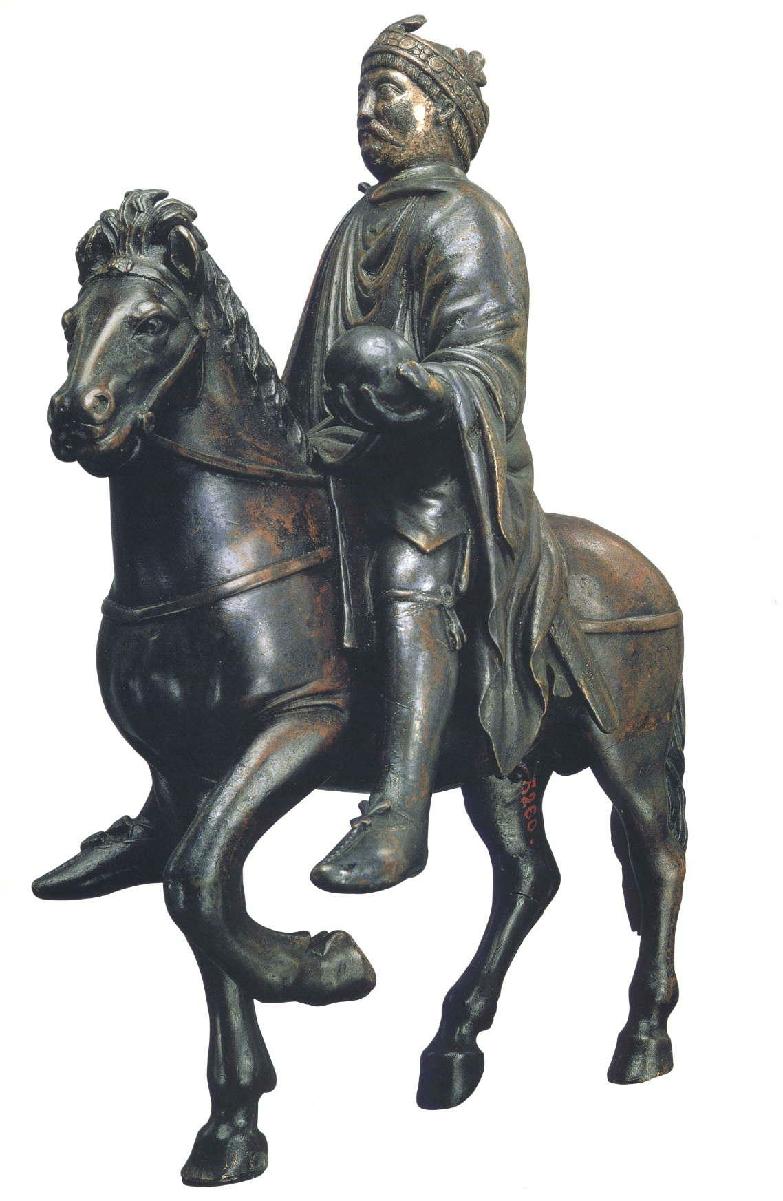
Equestrian bronze statuette
of Charlemagne (900s)
From the Treasury of the
Metz Cathedral (France)
He was at least 6
feet in height, with round face, thick in build – thus physically a very impressive
warrior
Paris, Musée du
Louvre
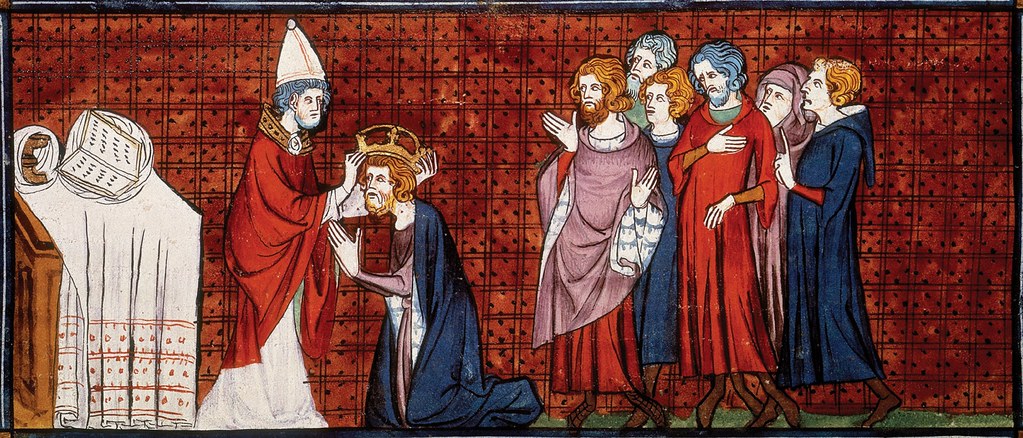
Charlemagne crowned emperor by Pope Leo III - Christmas 800
From Chroniques de France ou de Saint Denis (mid-1300s)
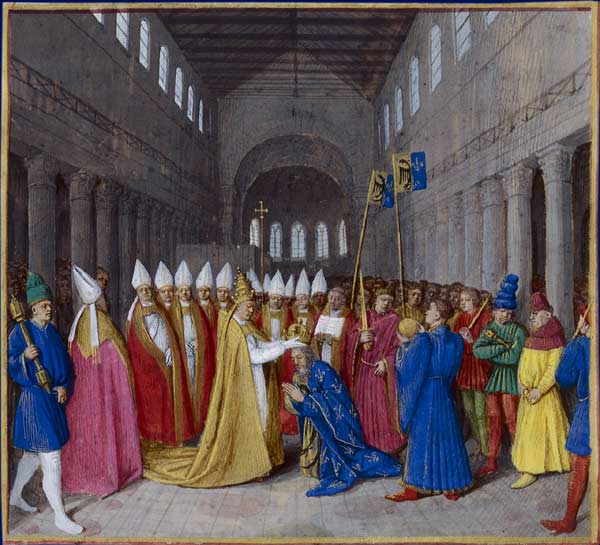
Charlemagne is crowned Emperor
by Pope Leo III - December 25, 800
by Jean Fouquet (Tours,
ca.1455-1460)
Paris, Bibliothèque
nationale de France, département des Manuscrits
THE "CAROLINGIAN RENAISSANCE" |
The roots of a significant cultural revival
When the Pope crowned Charlemagne as Roman Emperor, it seemed that
Europe was possibly on track to restore the lost grandeur of Roman
society and culture. Charlemagne's new empire brought political
stability ... and consequently economic development. And that in
turn stirred to life a dramatic intellectual-cultural revival ...
developed largely because Charlemagne himself was extremely interested
in cultivating scholarship within his empire ... especially as he
himself (typical of Germanic political leadership) could not read.
Consequently his capital at Aachen became a gathering place for
scholars, artists and builders. They came from all around this
diverse empire – and even beyond. His chief minister Alcuin was an
English clergyman, scholar, author, poet and teacher of logic from York
(not part of his empire). Charlemagne's court included also the
Spanish Visigoth poet and scholar Theodulf, the Lombard historian Paul
the Deacon, Roman-Italians grammarian Peter of Pisa and master
theologian Paulinus of Aquileia, and numerous Franks ... the
mathematician Einhard, the librarian Waldo, and the poet Angilbert,
among them.
Huge number of Latin works were rewritten in a simplified Latin script
(not just capitals but also "minuscules" or lower-case letters) ... to
make learning easier ... especially among the priests, many of whom
were illiterate. And the collection of valuable writings occurred
... producing key libraries.
Art and architecture also began a significant revival ... because of
the German contact with the Mediterranean world where "Romanesque"
architecture was still prevalent. Also, commercial relations with
the Muslim world (built heavily on the sale of slaves) exposed the
Carolingian world to more sophisticated art and architecture.
Overall, the Carolingian building program was immense with numerous new
cathedrals, hundreds of monasteries and around a hundred royal
residences constructed during the 80-year Carolingian period of
Charlemagne and his immediate successors.
But perhaps most important – certainly at least to Charlemagne – was
the moral and spiritual reform and strengthening of the Church,
Charlemagne becoming involved in refinements of the Church's theology
and doctrines. Charlemagne understood that a strong empire
depended on a strong moral culture at its base.
|

Raban Maur (left), supported
by Alcuin (middle),
dedicates his work to Archbishop Otgar of Mainz (Right)
The Englishman Alcuin was
considered the unsurpassed scholar in Charlemagne's court
Vienna, Österreichische
Nationalbibliothek

Page from the "Ebbo Gospels"
(St. Matthew) (816-835)
Épernay, Bibliothèque
municipale
The Lorsch Gospels (ca. 780–820)
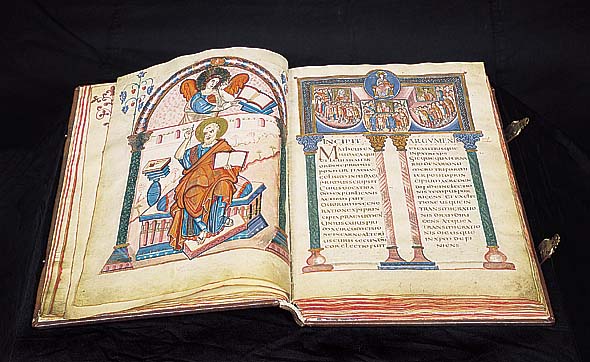

Lorsch Gospels (Codex Aureus
of Lorsch) 778–820 - Charlemagne's Court School
Ivory front book cover
Vatican, Bibliotheca
Apostolica

Lorsch Gospels
Ivory back book cover
London, Victoria and Albert
Museum

The Evangelist composing
his gospel
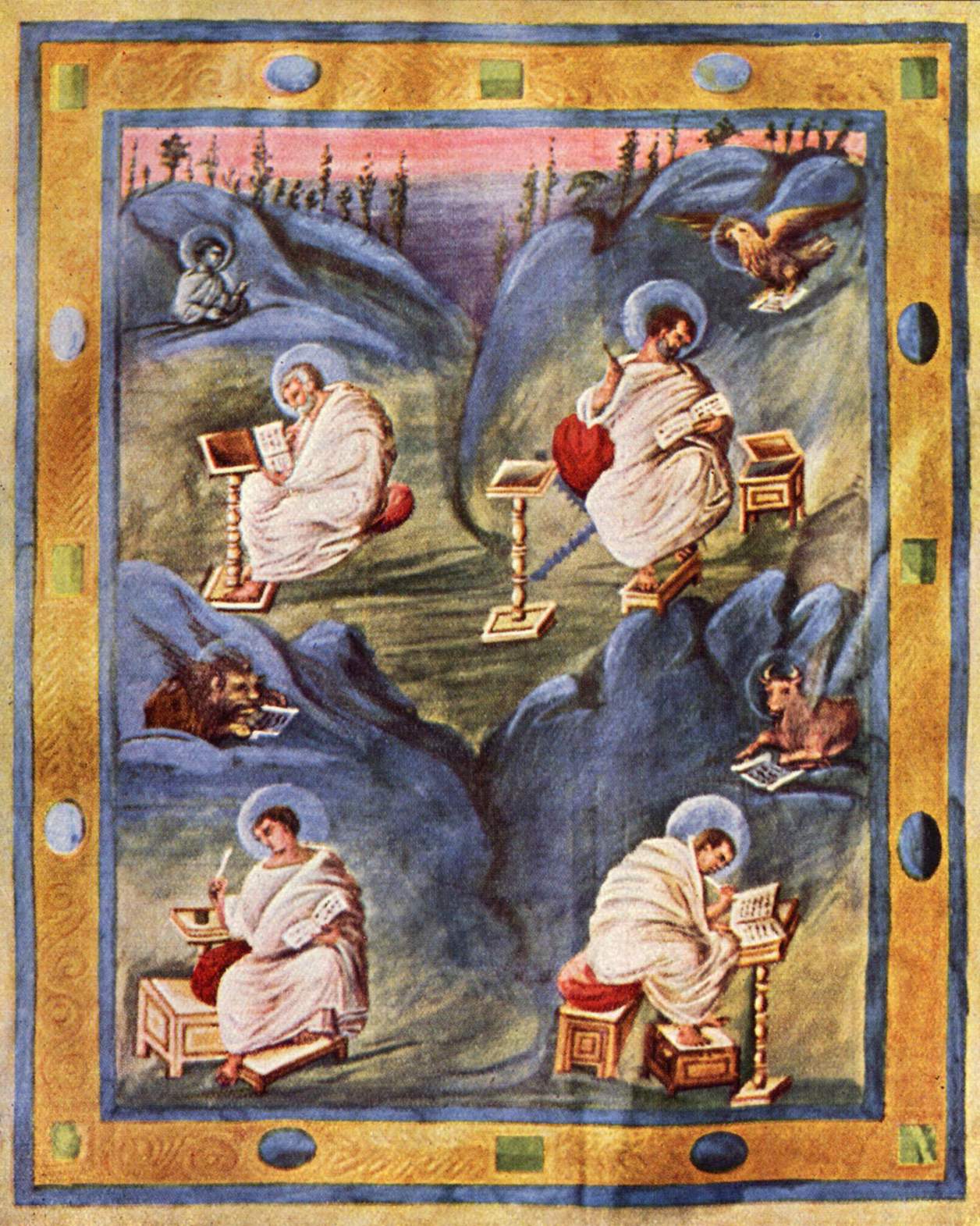
The Four Evangelicals (Matthew,
Mark, Luke and John)
from the Aachen Gospels (c. 820)
an example of Carolingian
illumination
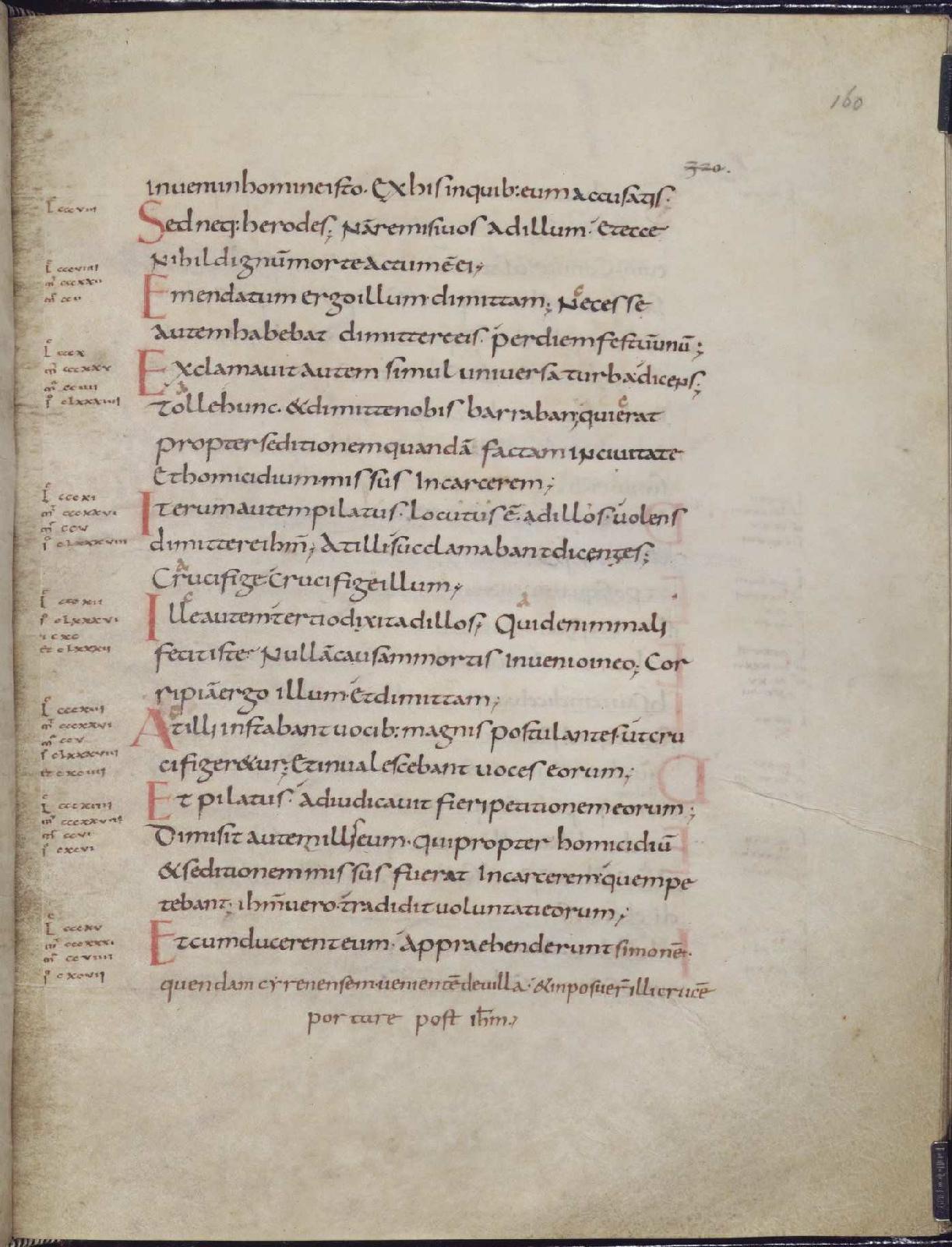
A page of text from a Carolingian
Gospel, written in Carolingian miniscule
The text is Luke
23:14-26
British Library
Architecture of the Carolingian "Renaissance"

Charlemagne's Octagon Cathedral
at Aachen

The octagonal interior of
Charlemagne's Cathedral at Aachen
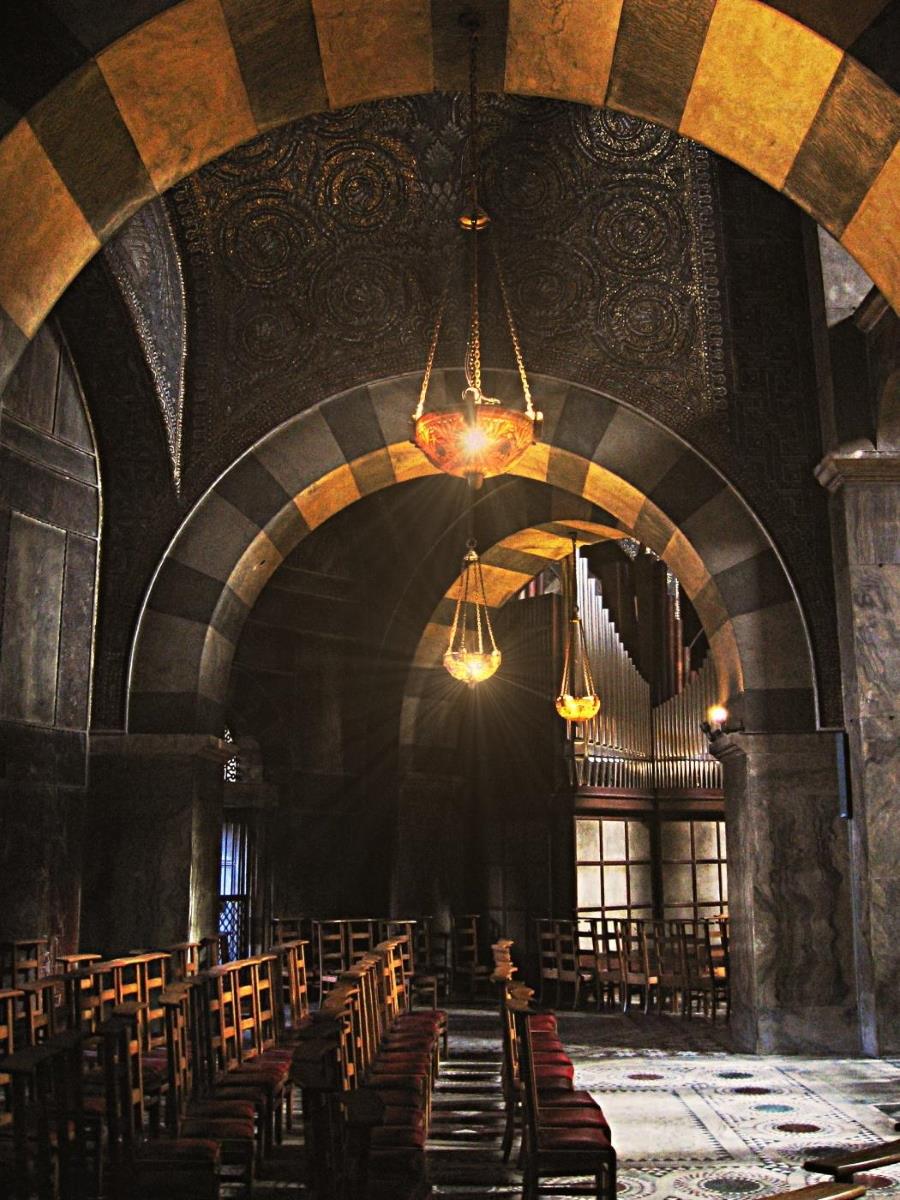
Charlemagne's chapel at Aachen
Cathedral
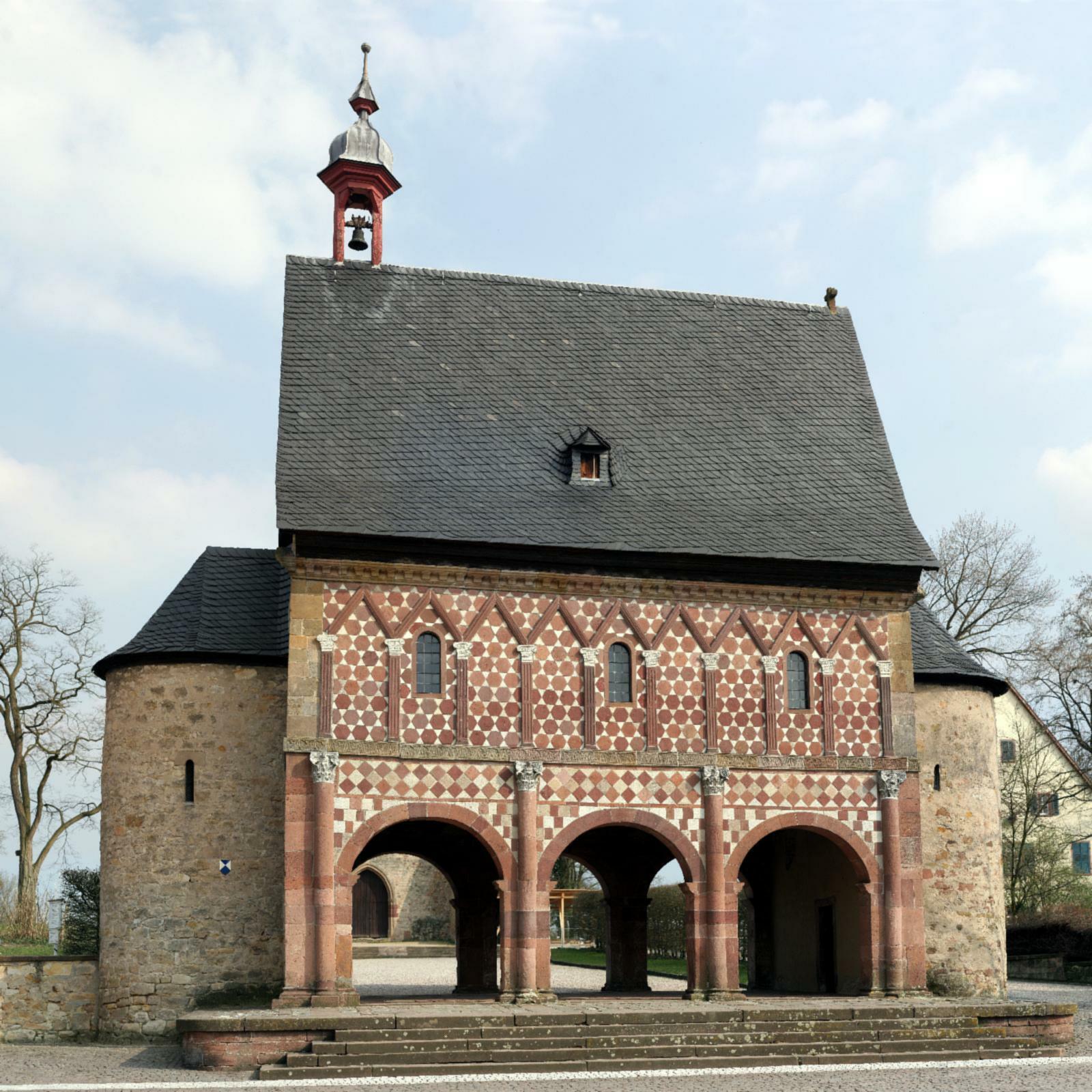
The Lorsch Monastery
Königshalle
(kings Hall)
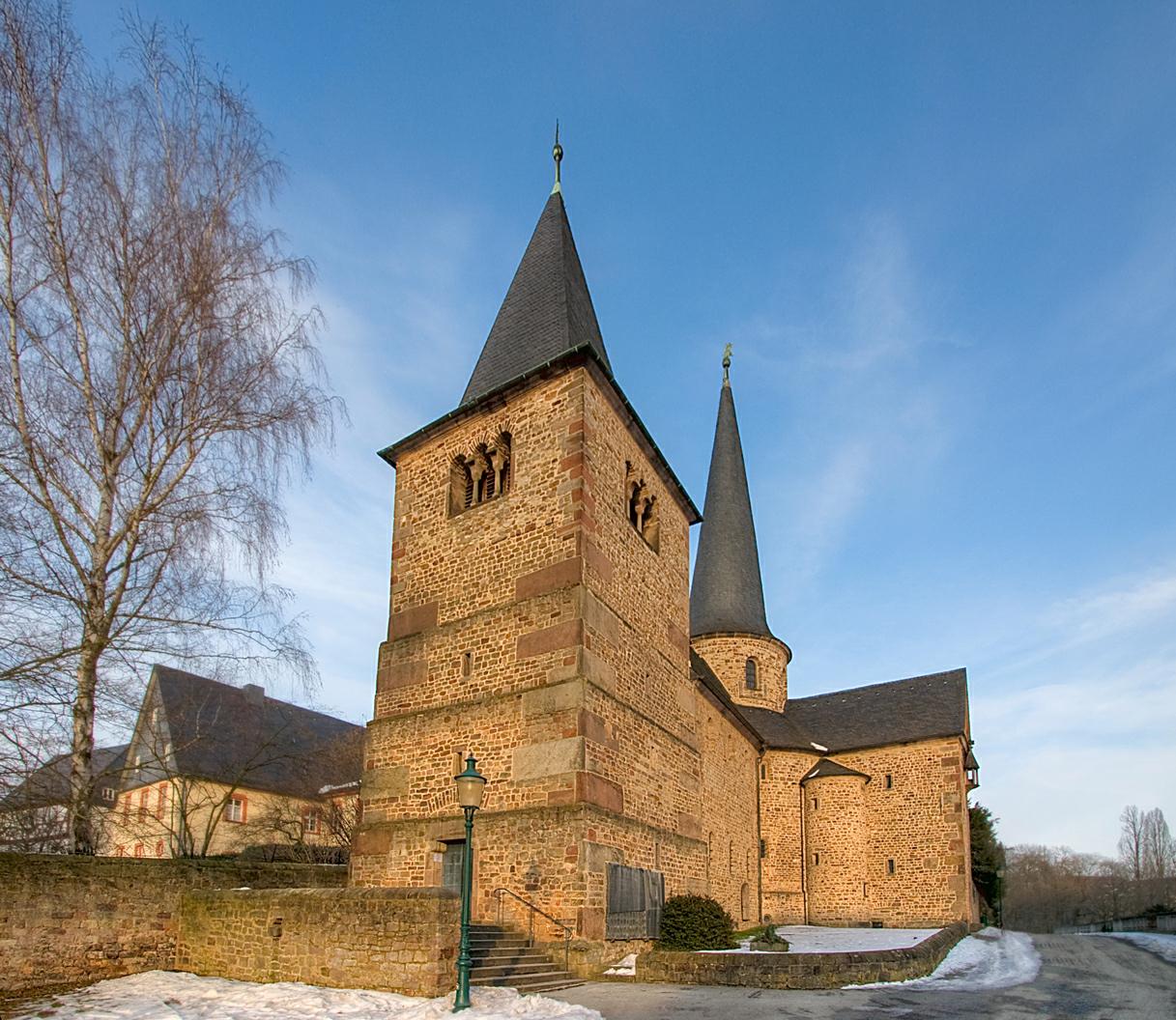
St. Michael's Church, Fulda
(820-822)
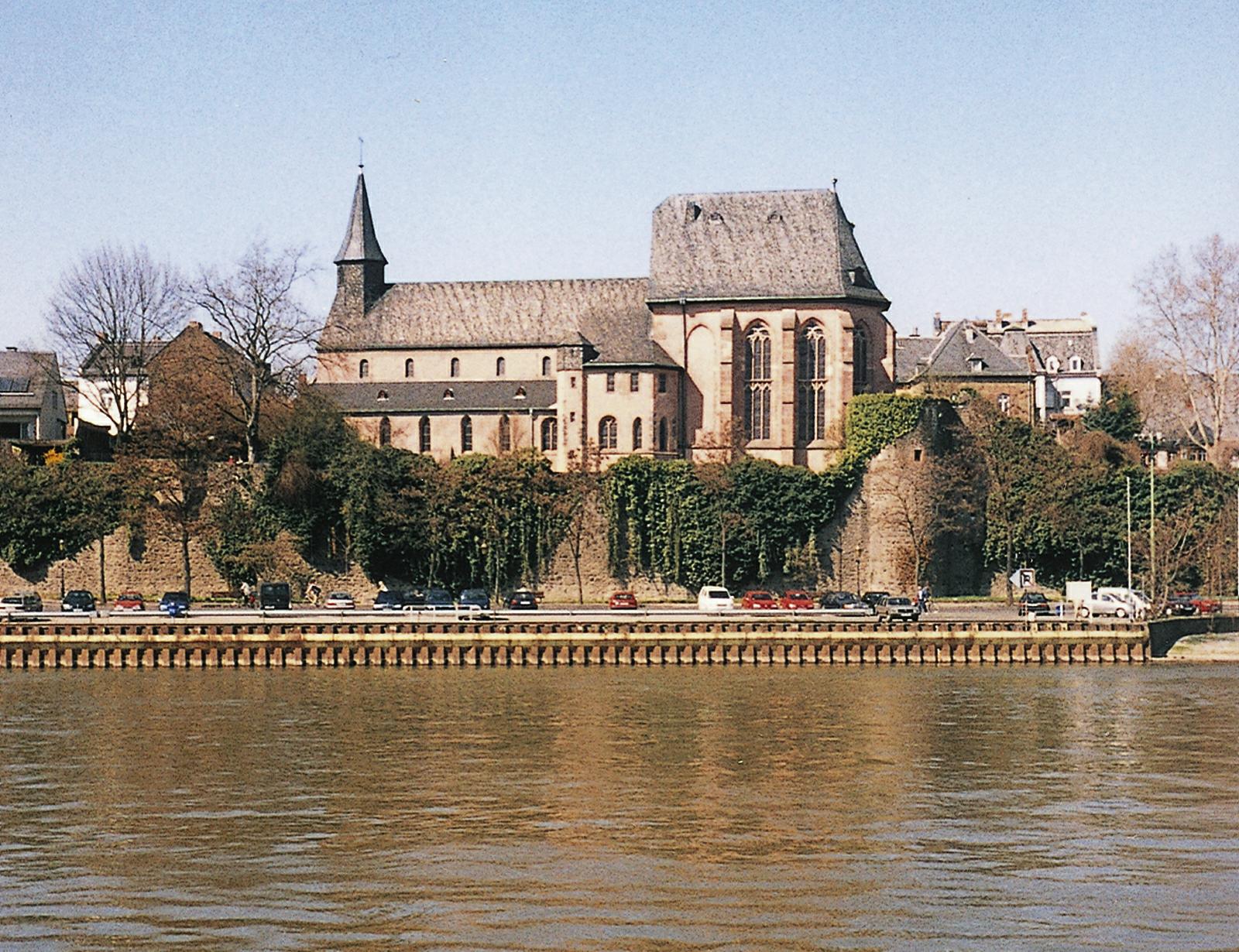
St. Justinus' church in
Frankfurt-Höchst
(830)
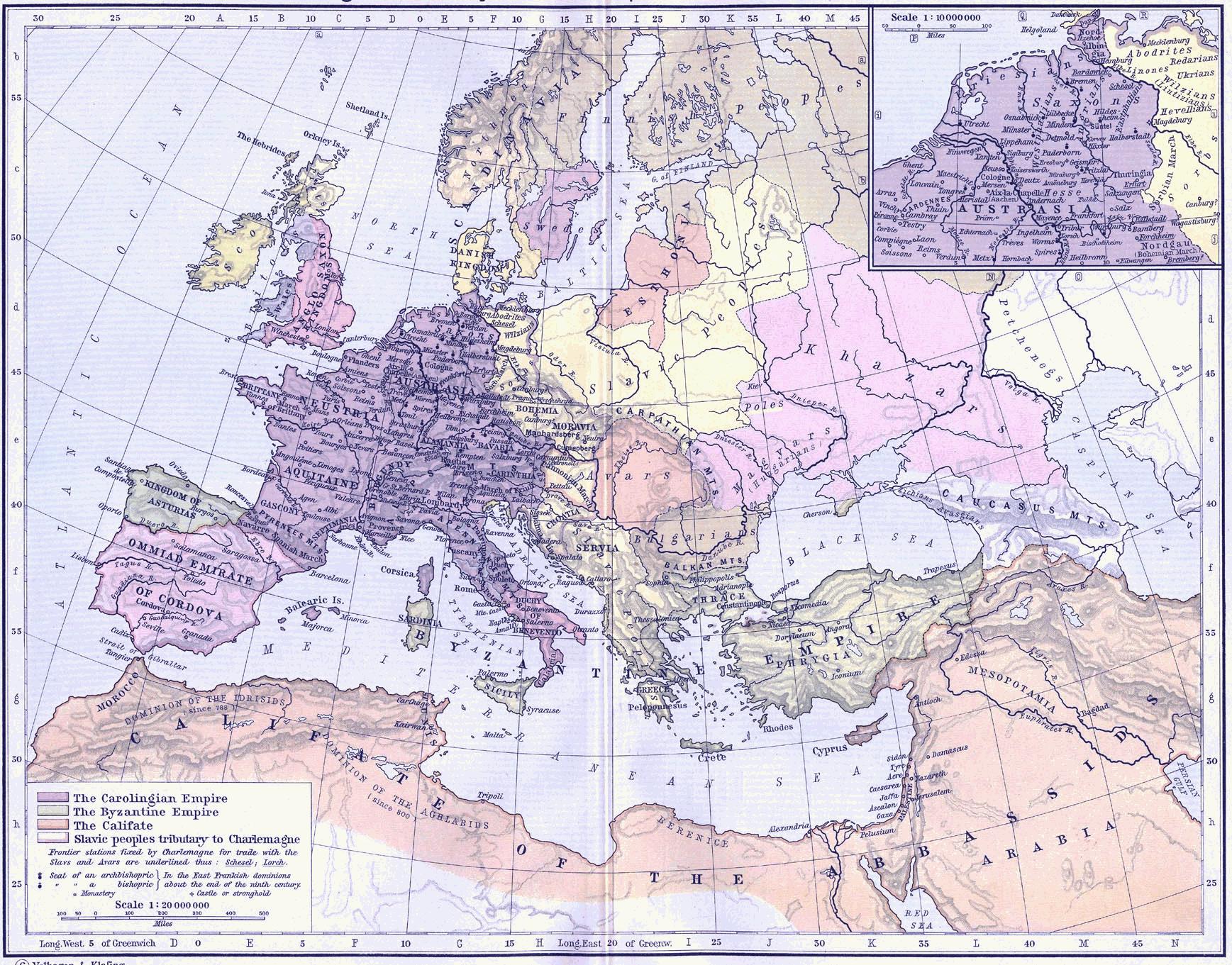
Europe around
800
William R. Shepherd, "The
growth of Frankish power, 481–814," Historical Atlas, 1926
edition

Go on to the next section: Decline ... and Recovery in the West
 Miles
H. Hodges Miles
H. Hodges
| | | | | |


 Islam challenges Western Europe
Islam challenges Western Europe
 Charles Martel - Defender and eventual
Charles Martel - Defender and eventual The retreat of the Umayyad dynast from
The retreat of the Umayyad dynast from The Spanish Reconquista gains
The Spanish Reconquista gains The founding of the Carolingian dynasty
The founding of the Carolingian dynasty

























